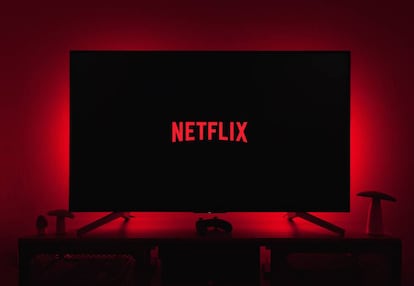Streaming services feel the winds of change
Netflix is losing users after years of dizzying growth. The economic crisis, changes in consumers’ habits and fierce competition from other platforms have transformed a rapidly evolving market


This week’s Netflix stock market crash has put the entire streaming sector on guard. The Californian company has lost tens of billions in capital after revealing that it lost 200,000 users in the last quarter. This marks the first time in the last decade that it has not gained customers, and it expects another two million to leave in the coming months. Investor panic also brought falls in the shares of two of Netflix’s main competitors: Disney, which runs the platform Disney+, and Warner Bros Discovery, which owns HBO Max.
Is the crisis exclusively for Netflix, or does it herald a change in the entire sector? Most analysts point to the latter. The CNN+ streaming channel, for example, just shut down after only a month. All services are facing the same series of problems. The primary issue is the current economic downturn. The pandemic, the energy crisis, the war in Ukraine and inflation are putting pressure on many consumers’ finances, and when users have to tighten their belts, subscription services are the first to go. Netflix will face the greatest hemorrhage of customers simply because it has the largest subscriber base, but no one will be saved.
Consumers have also evolved. A Deloitte report found last summer that young people, who experience more economic precarity and thus are more sensitive to price changes, often subscribe to and cancel the same service several times in the same year. “Some mature users analyze their subscriptions month by month,” explains Rodrigo Miranda, general director of ISDI (the Higher Institute for the Development of Internet). “This affects streaming platforms but also music and sports services.”

Netflix is also facing issues with profitability. Its recent model for growth–attracting users with impressively low prices–seems to be reaching the end of its viability. Now its needs to retain customers and make them profitable. To do so, Netflix needs to combat password sharing: the company’s executives estimate that 100 million users share their passwords with friends and family. The platform also needs to create new ways of monetizing its service, such as introducing advertising.
Other services have been exploring the last route for some time now. Amazon and HBO Max already show ads to whoever wants to pay less for their subscription. Disney+ has said it will do the same. Netflix has not ruled out the option, despite having always emphasized the absence of commercials on its platform. Morgan Stanley estimates that the company stands to make billions a year from selling ads. The arrival of advertising seems inevitable. “In many ways, we’re seeing the television of the last half century now being reincarnated in the age of streaming,” JB Perrette, the Warner Bros. Discovery executive in charge of video channels, said recently.
It would be rash to leave Netflix for dead. It may have lost 200,000 users, but it still has 221 million left, and its revenue has continued to grow: it generates about $30 billion a year. It remains the undisputed market leader. Its founder, Reed Hastings, made the decision to transform his DVD rental business into a streaming platform at the turn of the century, long before the internet worked as it does today. Analysts called him crazy, as they did when he set out to become the largest audiovisual production company in the world. But Hastings managed to convince investors, and his growth was unstoppable. It is estimated that during the first year of the pandemic Netflix was responsible for 11% of global internet traffic.
2016 was a landmark year for the company. That year, it expanded internationally, entering 130 countries. Studies indicate that it was then responsible for 40% of the nightly online traffic in the US. Some even proposed that internet service providers charge the company for abusing the installed fiber capacity. Everyone wanted to imitate the successful model. That year, Hastings uttered one of his most iconic phrases: when asked if he was worried about people sharing passwords, he said that “we love people sharing Netflix.” A few months earlier another said: “Netflix will never have ads.” Both statements are now in question.
The phase of capturing an audience has now ended. Until now, the company had not considered ways to make its customer base profitable, simply because the constant customer growth did not require it. That curve had to flatten eventually. “What is happening with Netflix is not new. We have already seen it in other subscription models, such as insurers or mobile operators”, says Miranda. “The expensive thing, really expensive and difficult, is to get the user, and they have already done that.”
Now it’s time to retain customers, either through reducing prices through advertising or with special content. They could even offer new services, such as video games, an idea that has caused wide speculation. “We have no plan to enter the video game sector,” Hastings himself told EL PAÍS Retina four years ago. He has not officially changed his mind.
Netflix has made it into the pantheon of major tech companies. Some US media have even reformulated the acronym to refer to the internet giants: from GAFA (Google, Amazon, Facebook and Apple), it became FAANG. The company’s inclusion is meant not only to highlight its economic power (it came to surpass 300 billion dollars in stock market value), but to include among the companies that have perfected the art of extracting and exploiting huge amounts of user data.
One of the keys to the platform’s success lies in how it handles that information. Its content recommendation algorithm, based on viewers’ own ratings, has been extensively studied. Netflix also uses big data in its productions. The company’s analysts, for example, noticed that the British series House of Cards was a hit, as were movies by actor Kevin Spacey and director David Fincher. “They identified that at the intersection of those three elements was a huge potential audience,” data scientist Mark Tenenholtz said. To generate buzz, they showed advertisements for their adaptation of the 1990 series to viewers who interacted with any of these three elements. The result was one of Netflix’s (and television’s) biggest hits to date.
Almost all of the major streaming platforms, excluding Apple TV, sell their customers’ data to third parties, as a Common Sense report showed last year. Their objective is to enrich and complement the profiles they create of users. “When I transfer he data to a third party, I can have a reciprocal equivalent. You gain information about usage, interests or situations that helps you hyper-personalize ads. Netflix customers could not watch conventional advertising. They need something super targeted,” says Miranda.
Netflix has agreements, for example, with Meta. If someone posts on Instagram that they’re feeling sad, they may open Netflix to see recommendations for moody movies. These are the moments when we suspect that the machines are listening to us.
Tu suscripción se está usando en otro dispositivo
¿Quieres añadir otro usuario a tu suscripción?
Si continúas leyendo en este dispositivo, no se podrá leer en el otro.
FlechaTu suscripción se está usando en otro dispositivo y solo puedes acceder a EL PAÍS desde un dispositivo a la vez.
Si quieres compartir tu cuenta, cambia tu suscripción a la modalidad Premium, así podrás añadir otro usuario. Cada uno accederá con su propia cuenta de email, lo que os permitirá personalizar vuestra experiencia en EL PAÍS.
¿Tienes una suscripción de empresa? Accede aquí para contratar más cuentas.
En el caso de no saber quién está usando tu cuenta, te recomendamos cambiar tu contraseña aquí.
Si decides continuar compartiendo tu cuenta, este mensaje se mostrará en tu dispositivo y en el de la otra persona que está usando tu cuenta de forma indefinida, afectando a tu experiencia de lectura. Puedes consultar aquí los términos y condiciones de la suscripción digital.










































